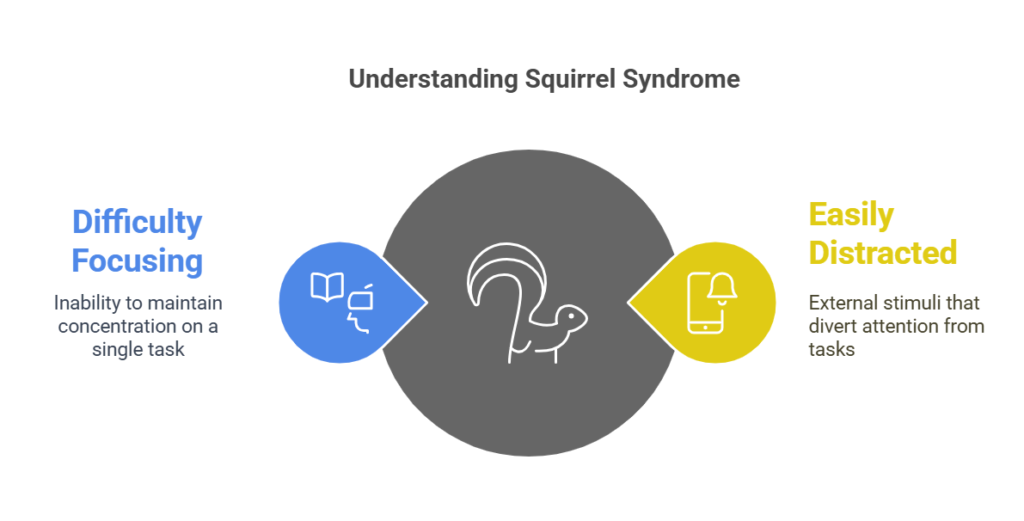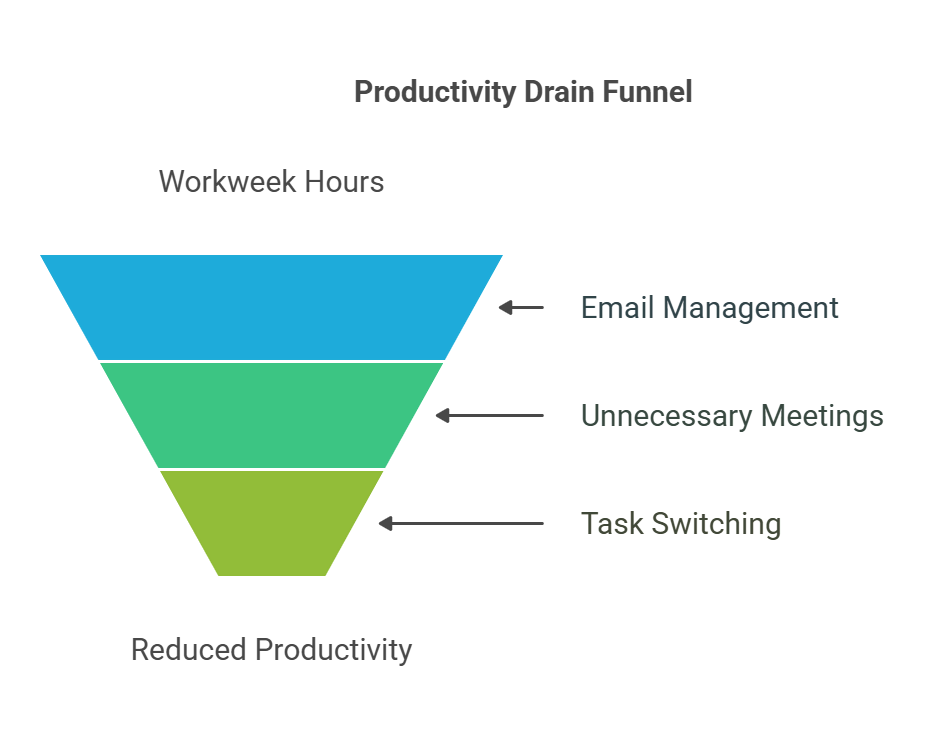Modern day office workspaces, whether working remote or office-based, are filled with distractions. Imagine this You’re working on something important, completely in the zone, and then—ding! Your phone lights up with a notification. Maybe it’s an email, a message, or some random app reminding you it exists. Before you know it, you’ve spent ten minutes scrolling through social media or checking your inbox. Sound familiar? If so, you might have experienced what many call “Squirrel Syndrome.”

This phrase comes from the image of a squirrel darting from one tree to another, unable to focus on just one. For us humans, it’s the endless jumping from task to task, driven by distractions, that keeps us from getting anything meaningful done. Let’s dive into why this happens, how it’s affecting your productivity, and—most importantly—what you can do about it.
Why Distractions Feel So Hard to Resist
Ever wonder why it’s so tough to ignore that little red notification bubble? The answer lies in your brain. Every time you respond to a new stimulus—whether it’s a text, a headline, or even a passing thought—your brain rewards you with a tiny hit of dopamine. It’s the same chemical that makes eating chocolate or getting a compliment feel good. In short, your brain loves new and shiny things.
But there’s a catch: chasing these dopamine hits doesn’t actually make you happier or more productive. In fact, it trains your brain to crave interruptions, making it harder to stay focused on the task at hand. Over time, this constant switching between tasks—also known as context-switching—drains your mental energy and leaves you feeling frazzled.
So here is a tip Try this 20-second rule that makes distractions slightly harder to access. Put your phone in another room or turn off notifications while you work. Creating even a tiny barrier can help your brain resist the urge to chase that next dopamine hit.
The Cost of Squirrel Syndrome
The Productivity Puzzle

You might think a few distractions here and there aren’t a big deal, but the numbers tell a different story. Did you know that every time you get distracted, it takes about 23 minutes and 15 seconds to get your focus back? Yep, that’s according to a study from the University of California, Irvine. Now, think about how often you get interrupted during the day—emails, phone calls, random notifications—it all adds up. Before you know it, you’ve lost hours, not just in time but in mental energy. It’s like trying to sprint through quicksand! Isn’t that wild? It really makes you think about how important it is to guard your focus like it’s gold.
The Price of Distractions
Let’s talk about how much time we actually spend not working while at work. According to a 2023 report from McKinsey & Company, knowledge workers spend nearly 28% of their week wrangling emails—basically a quarter of their time just clicking through their inbox! Add another 14% lost to meetings that didn’t need to happen and constantly switching between tasks, and bam—over 40% of your potential productivity goes right out the window. Wild, right?

And here’s where it gets even crazier: for big companies, those distractions come with a hefty price tag. A 2022 survey of Fortune 500 companies found that distractions can cost up to $588 billion a year in wasted productivity. Yep, billion with a B. That’s missed deadlines, sloppy work, and employees hitting burnout because their brains are doing too much juggling. Makes you think twice about leaving all those notifications on, huh?

And it’s not just about time. Constant distractions can:
- Reduce the quality of your work: When your brain keeps switching gears, it struggles to get into a state of deep focus.
- Increase stress levels: A cluttered mind often leads to feeling overwhelmed and anxious.
- Lead to burnout: Always being “on” can leave you mentally and emotionally drained.
Relatable Example:
Imagine you’re writing an important report. You’ve barely written a paragraph when an email pops up. You check it, reply, and then remember you need to update a spreadsheet. By the time you return to the report, you’ve forgotten your train of thought. Repeat this cycle a few times, and suddenly the report takes twice as long to finish—if you finish it at all.
Schedule focus blocks: Dedicate specific times in your day to uninterrupted work. Use a timer (like the Pomodoro technique) to work for 25 minutes, then take a 5-minute break. It’s a simple way to train your brain to stay on task.
Why We Can’t Resist Distractions
Ever wonder why it’s so hard to ignore that buzzing phone or the ping of a new email? Turns out, our brains are hardwired for it. Dr. Gloria Mark, a pro when it comes to attention management, says we’re naturally drawn to novelty. Basically, every time we check something new—like a notification or a message—our brains reward us with a little dopamine hit. It’s like a tiny “woohoo” from your brain, which makes it nearly impossible to resist.
And let’s be real, the whole hybrid work setup hasn’t helped. With the lines between work and home totally blurred, distractions are sneaking into every part of our day. One second you’re writing an important report, and the next, you’re scrolling through social media or deciding you need to reorganize your kitchen drawer. Staying focused has never been harder! Crazy, right?
Many of us pride ourselves on juggling multiple things at once, but studies show that multitasking can reduce productivity by up to 40%. Your brain isn’t actually doing two things at once; it’s switching back and forth, which takes extra time and energy.
Adopt a “single-tasking” mindset. Focus on one task at a time, and don’t move on until it’s complete. If you’re tempted to multitask, remind yourself that quality beats quantity every time.
How to Tame Your Inner Squirrel
Got a case of Squirrel Syndrome? You know, when every little thing grabs your attention, and before you know it, you’re five rabbit holes deep on the internet. The good news? It doesn’t have to be that way. With a few simple tweaks, you can train your brain to focus and actually get stuff done without feeling totally frazzled. Let’s dive in.

1. Declutter Your Digital Space
Think of your digital world—your desktop, email, or phone screen—as your workspace. If it’s jam-packed with apps, tabs, and notifications, it’s like trying to work on a desk buried under a mountain of junk. Here’s how to tidy up:
- Unsubscribe from emails you never read (seriously, when’s the last time you looked at that newsletter?).
- Sort your files into folders so you don’t waste time searching for stuff.
- Limit your open tabs to just what you actually need.
Why It Works: Clutter, whether it’s physical or digital, messes with your brain. The less chaos you’ve got around you, the easier it is to focus. Fun fact: a study from Princeton University found that people working in tidy spaces focused 30% better than those surrounded by clutter. That’s motivation to clean house, right?
2. Set Clear Boundaries
Ever feel like you’re “always on” and can’t catch a break? That’s what happens when there are no boundaries between work and personal time. To protect your focus (and your sanity):
- Tell your coworkers, family, or roommates when you’re in “do not disturb” mode.
- Use calendar blockers so people know when you’re busy.
- Turn off work notifications once you’re done for the day.
Why It Works: Boundaries are like fences for your brain—they keep the stress out and give you room to breathe. Plus, knowing when it’s okay to focus and when it’s time to relax can seriously lower your stress. Because let’s be real, you can’t pour from an empty cup.
3. Take Care of Your Brain
Your brain is like a fancy sports car—it needs the right fuel to run at its best. If you’re not giving it what it needs, don’t be surprised if it sputters out halfway through the day. Here’s how to keep your mental engine humming:
- Sleep: Aim for 7-8 hours a night. Research shows sleep deprivation can tank your focus by up to 60%.
- Eat Smart: Fuel up with brain foods like berries, nuts, and leafy greens. Think of it as premium gas for your brain.
- Move: Even a quick 10-minute walk can boost your concentration by 15%. Easy win, right?
Why It Works: When you take care of your brain, it takes care of you. Treat it well, and it’ll help you crush your goals instead of crashing mid-task.
4. Practice Mindfulness
Mindfulness might sound a little woo-woo, but trust me, it’s legit. It’s all about training your brain to stay present, which makes it a whole lot easier to focus on what you’re doing. Start small:
- Take a few deep breaths before diving into a task.
- Try apps like Headspace or Calm for guided meditations.
- If your mind starts to wander, gently bring it back to what you’re doing—no judgment.
Why It Works: A 2018 study in Psychological Science found that just 10 minutes of mindfulness a day can improve focus and decision-making. It’s like a daily workout for your attention span.
5. Build a Focus-Friendly Routine
Routines might sound boring, but they’re actually the secret sauce to staying on track. When your brain knows what’s coming next, it spends less energy deciding and more energy doing. Here’s how to create one:
- Start your day with a “power hour” where you focus on your most important task before checking emails or social media.
- Plan your top three priorities for the day in advance.
- End your workday with a quick review of what you got done (and give yourself a little pat on the back).
Why It Works: Routines create momentum, and momentum makes everything easier. When you’ve got a flow going, you’re less likely to get derailed by distractions.
Create a “focus ritual” to signal your brain that it’s go time. It could be something as simple as lighting a candle, putting on your favorite focus playlist, or sipping a cup of tea before starting work. Think of it as flipping the switch from “chill mode” to “get-it-done mode.”
Final Thoughts
Squirrel Syndrome might feel like a constant battle, but with the right tools and mindset, you can regain control of your time and energy. Start small, experiment with different strategies, and find what works for you. Before you know it, you’ll be tackling your to-do list with laser-like focus—and maybe even have time left over to enjoy the things that truly matter.
Study & References
Here are the individual studies and references mentioned in the article:
- Time to Regain Focus After Distractions
A study by the University of California, Irvine, found that it takes an average of 23 minutes and 15 seconds to refocus after an interruption.
Read more - Impact of Clutter on Focus
Research from Princeton University suggests that cluttered environments negatively affect focus, as our brains respond better to order.
Read more - Mindfulness and Decision-Making
A study published in Psychological Science indicates that mindfulness meditation can improve decision-making and attention.
Read more - Cost of Workplace Distractions
Workplace distractions cost U.S. businesses up to $588 billion annually, according to Basex.
Read more - Productivity of Knowledge Workers
A McKinsey & Company report highlights how interruptions reduce the productivity of knowledge workers.
Read more - Mindfulness Meditation and Cognitive Function
Research shows that practicing mindfulness meditation for just 10 minutes a day improves focus and working memory.
Read more







